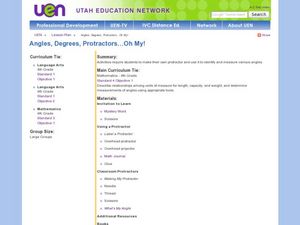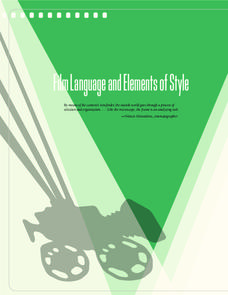Curated OER
Culture Sharing: History, Politics, Government
Students explore types of governments and political systems. In partners, students share information about their home country. Classmates work together to prepare a presentation about the history and government of a specific country.
Judicial Learning Center
Levels of the Federal Courts
The Supreme Court gets all the glory, but very few federal cases make it to the highest court. An interesting lesson explores the structure of the lower levels of the federal court system. In addition to outlining the organization of...
Curated OER
An Introduction to Law
With so many different types of law, it can be difficult for learners to discern which is which! Use a newspaper to give tangible examples of various types of law, including criminal, civil, consumer, family, local, state, federal and...
Utah Education Network (UEN)
Angles, Degrees, Protractors . . . Oh My!
Fourth and fifth graders make a protractor and identify various angle types. In this protractor and angle lesson, learners make their own protractor and use it to measure a variety of angles. They complete worksheets while identifying...
Federal Reserve Bank
“W” Is for Wages, W-4 and W-2
Don't let your young adults get lost in the alphabet soup of their paychecks and federal income taxes. Using sample pay stubs and reproductions of government forms, your class members will identify the purpose of such forms as a W-4 and...
Curated OER
Personal Body Types
Students become familiar with four major body types; assess their own bodies, and complete an assignment showing which styles and design details would look best on different body types.
Curated OER
Judicial Branch & Supreme Court Questions
In this U. S. government worksheet, students respond to 19 short answer questions about the responsibilities of Supreme Court members in the United States.
Curated OER
Play: Types of Play
Students identify the different types of play and examine how play helps students grow and develop. They read case studies and identify the types of play represented, and observe students playing in group situations.
Curated OER
I'm The Taxman!
Learners develop an understanding of how federal revenues are gained by taxes. This foundation enable students to decipher changes in federal tax policy. Groups of learners study different types of taxes and prepare presentations on each...
Curated OER
Lessons from the Holocaust
Students discover what a dictatorship is by examining the holocaust. In this government instructional activity, students discuss the laws that were enacted for Nazis to take control of Germany, and the types of laws we have put...
Curated OER
Montana Reservation Governments
Third graders examine the types of governments on Indian reservations. In groups, they research the responsibilities of local and tribal governments. As a class, they discuss how the state of Montana meets the needs of its citizens...
Curated OER
Branches of Government Graphic
Students explore the three branches of government. They create a graphic diagram to show each branch of government. Students include the qualifications for service and duties of each branch of government in their graphic diagram.
Curated OER
The Economy and Politics
For this economy and politics sociology worksheet, students complete 14 fill in the blank questions and 7 multiple choice questions regarding the how businesses operate in different economies and under various political control.
Judicial Learning Center
The Appeal Process
Why doesn't the Supreme Court hear testimony from witnesses? How do they complete an entire proceeding in less than two hours? A helpful lesson guides scholars of criminology through these and other questions by explaining how appeals...
Curated OER
Types of Love (Dat)
Students examine the different types of love. They identify the various types of love and the behaviors associated with each. Although there are many kinds of love that we need to receive daily, most people will experience only one or...
Curated OER
Investigation 3 - Weathering
Fourth graders study 4 types of weather processes: wind, running water, plant growth, and freezing water. They explain how the processes of weathering and erosion change and move materials that become soil. They draw diagrams...
Curated OER
Finding Meaning in the Badge
Children who are three to five years old study two rank badges from the Qing dynasty to develop an understanding of social rank, language skills, and symbolism. The lesson is discussion-based and requires learners to compare and contrast...
Utah State Courts
Judges in the Classroom
Class members explore the process of a disposition hearing for juveniles, particularly looking at how the judge decides what sentence the juvenile offender should receive. Task your pupils with evaluating different sample cases provided...
Curated OER
The U.S. Constitution
Students explain the differences between the three branches of government. Using the structure of a democracy, they listen to text about the United States Constitution. They discover how their government affects their lives in negative...
Curated OER
Government Lesson Plans
Students can learn how their government is organized through these engaging lesson plans.
Curated OER
George Washington and the Rule of Law
students compare The rule of law with the rule of men and consider life under each of these types of governments.In this government lesson, students read a primary source to examine the importance of the rule of law.They will also answer...
Film Foundation
Film Language and Elements of Style
How do you read a frame? How do you read a shot? Here's a resource that shows viewers how to read films. As part of the study, class members examine the camera angles, lighting, movement, and cinematic point of view in Mr. Smith Goes to...
Curated OER
Government & Politics
In this United States history worksheet, students reference their textbook to answer 16 fill in the blank questions and 8 short answer questions regarding the early government of the nation.
Curated OER
Fossil Formation Fun
Students compare the three types of fossils: preserved organisms, mineral replacement fossils, and impression fossils. They create a model of amber,
sponge fossil, and make traces of fossil.

























